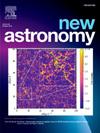短周期接触双星 V724 And 的光度研究
IF 1.9
4区 物理与天体物理
Q2 ASTRONOMY & ASTROPHYSICS
引用次数: 0
摘要
我们对 V724 And 进行了新的光曲线合成和轨道周期变化分析。我们发现它是一个 W 亚型接触双星系统,质量比为 q = 2.31,填充因子为 f = 10.8%。较弱的奥康纳尔效应可以用质量较大的组成恒星上的冷星点来解释。通过分析轨道周期的变化,可以发现该目标在周期性振荡的基础上又出现了周期性下降。轨道周期的下降速率为 dp/dt = -4.13 × 10-8 d yr-1,这可以用质量较大的成分向质量较小的成分的质量转移来解释。新发现表明,周期变化的半振幅和周期分别为 A = 0.0013 d 和 P = 10.54 yr,这意味着 V724 And 可能是一个三重系统。三级伴星的最小质量估计为 M3min = 0.054 M⊙,它在中心双星系统的形成和演化过程中起着重要作用。本文章由计算机程序翻译,如有差异,请以英文原文为准。
Photometric study for the short period contact binary V724 And
We present the new light curve synthesis and orbital period change analysis of V724 And. We found that it is a W-subtype contact binary system with a mass ratio of q = 2.31 and a fill-out factor of f = 10.8%. The weak O’Connell effect can be explained by a cool star-spot on the more massive component star. By analyzing orbital period changes, it is found that the target displays a secular period decrease superimposed on a cyclic oscillation. The orbital period decreases at a rate of dp/dt = −4.13 × 10−8 d yr−1, which can be explained by the mass transfer from the more massive one to the less massive component. The new discovery suggests that the semi-amplitude and period of the cyclic variation are A = 0.0013 d and P = 10.54 yr, respectively, which implies that V724 And is a possibly triple system. The minimum mass of the tertiary companion is estimated as M = 0.054 M, which plays an important role during the formation and evolution of the central binary system.
求助全文
通过发布文献求助,成功后即可免费获取论文全文。
去求助
来源期刊

New Astronomy
地学天文-天文与天体物理
CiteScore
4.00
自引率
10.00%
发文量
109
审稿时长
13.6 weeks
期刊介绍:
New Astronomy publishes articles in all fields of astronomy and astrophysics, with a particular focus on computational astronomy: mathematical and astronomy techniques and methodology, simulations, modelling and numerical results and computational techniques in instrumentation.
New Astronomy includes full length research articles and review articles. The journal covers solar, stellar, galactic and extragalactic astronomy and astrophysics. It reports on original research in all wavelength bands, ranging from radio to gamma-ray.
 求助内容:
求助内容: 应助结果提醒方式:
应助结果提醒方式:


